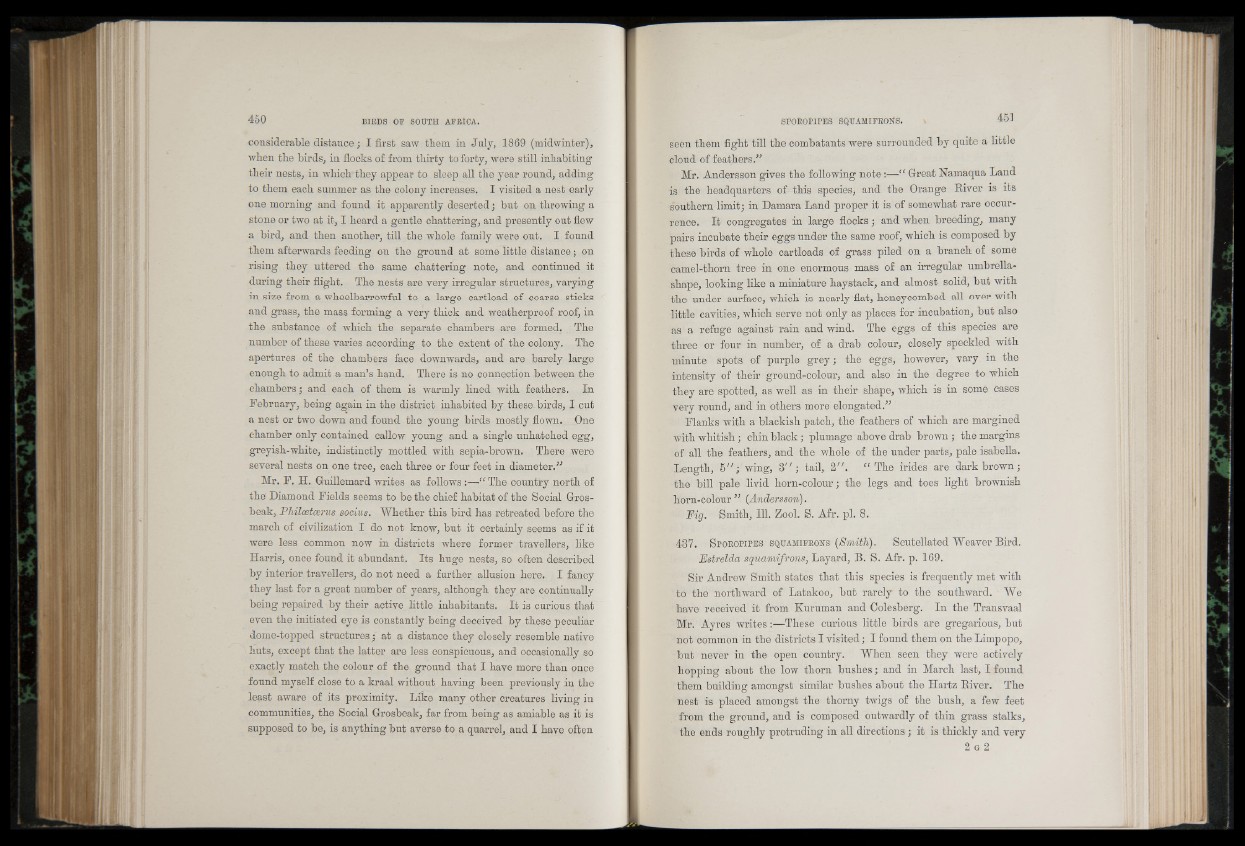
considerable distance; I first saw them in July, 1869 (midwinter),
when the birds, in flocks of from thirty to forty, were still inhabiting
their nests, in which they appear to sleep all the year round, adding
to them each summer as the colony increases. I visited a nest early
one morning and found it apparently deserted; but on throwing a
stone or two at it, I heard a gentle chattering, and presently out flew
a bird, and then another, till the whole family were out. I found
them afterwards feeding on the ground at some little distance; on
rising they uttered the same chattering note, and continued it
during their flight. The nests are very irregular structures, varying
in size from a wheelbarrowful to a large cartload of coarse sticks
and grass, the mass forming a very thick and weatherproof roof, in
the substance of which the separate chambers are formed. . The
number of these varies according to the extent of the colony. The
apertures of the chambers face downwards, and are barely large
enough to admit a man’s hand. There is no connection between the
chambers; and each of them is warmly lined with feathers. In
February, being again in the district inhabited by these birds, I cut
a nest or two down and found the young birds mostly flown. One
chamber only contained callow young and a single unhatched egg,
greyish-white, indistinctly mottled with sepia-brown. There were
several nests on one tree, each three or four feet in diameter.'”
Mr. F. H. Guillemard writes as follows:—“ The country north of
the' Diamond Fields seems to be the chief habitat of the Social Grosbeak,
Philcetcerus socius. Whether this bird has retreated before the
march of civilization I do not know, but it certainly seems as if it
were less common now in districts where former travellers, like
Harris, once found it abundant. Its huge nests, so often described
by interior travellers, do not need a further allusion here. I fancy
they last for a great number of years, although they are continually
being repaired by their active little inhabitants. It is curious that
even the initiated eye is constantly being deceived by these peculiar
dome-topped structures | at a distance they closely resemble native
huts, except that the latter are less conspicuous, and occasionally so
exactly match the colour of the ground that I have more than once
found myself close to a kraal without having been previously in the
least aware of its proximity. Like many other creatures living in
communities, the Social Grosbeak, far from being as amiable as it is
supposed to be, is anything but averse to a quarrel, and I have often
seen them fight till the combatants were surrounded by quite a little
cloud of feathers.”
Mr. Andersson gives the following note:—“ Great Namaqua Land
is the headquarters of this species, and the Orange River is its
southern limit; in Damara Land proper it is of somewhat rare occurrence.
It congregates in large flocks; and when breeding, many
pairs incubate their eggs under the same roof, which is composed by
these birds of whole cartloads of grass piled on a branch of some
camel-thorn tree in one enormous mass of an irregular umbrella-
shape, looking like a miniature haystack, and almost solid, but with
the under surface, which is nearly flat, honeycombed all over with
little cavities, which serve not only as places for incubation, but also
as a refuge against rain and wind. The eggs of this species are
three or four in number, of a drab colour, closely speckled with
minute spots of purple grey; the eggs, however, vary in the
intensity of their ground-colour, and also in the degree to which
they are spotted, as well as in their shape, which is in some cases
very round, and in others more elongated.”
Flanks with a blackish patch, the feathers of which are margined
with whitish ; chin black; plumage above drab brown; the margins
of all the feathers, and the whole of the under parts, pale isabella.
Length, 5” ; wing, 3 " ; tail, 2//. “ The irides are dark brown;
the bill pale livid horn-colour; the legs and toes light brownish
horn-colour ” (Andersson).
Fig. Smith, 111. Zool. S. Afr. pi. 8.
437. S p o r o p i p e s s q u a m i f r o n s {Smith). Scutellated Weaver Bird.
Estrelda squamifrons, Layard, B. S. Afr. p. 169.
Sir Andrew Smith states that this species is frequently met with
to the northward of Latakoo, but rarely to the southward. We
have received it from Kuruman and Colesberg. In the Transvaal
Mr. Ayres writes:—These curious little birds are gregarious, but
not common in the districts I visited; I found them on the Limpopo,
but never in the open country. When seen they were actively
hopping about the low thorn bushes; and in March last, I found
them building amongst similar bushes about the Hartz River. The
nest is placed amongst the thorny twigs of the bush, a few feet
from the ground, and is composed outwardly of thin grass stalks,
the ends roughly protruding in all directions; it is thickly and very